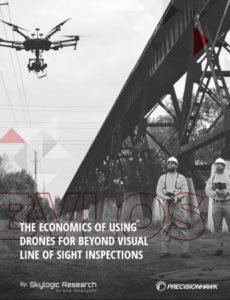 PrecisionHawk and Skylogic Research have just published a whitepaper in which they highlight the economic benefits of using drones for BVLOS operations across various industries. Specifically, the report details how the economics of BVLOS compare with visual-line-of-sight drone operations, as well as more traditional methods such as manual inspections or the use of manned aircraft.
PrecisionHawk and Skylogic Research have just published a whitepaper in which they highlight the economic benefits of using drones for BVLOS operations across various industries. Specifically, the report details how the economics of BVLOS compare with visual-line-of-sight drone operations, as well as more traditional methods such as manual inspections or the use of manned aircraft.
Beyond visual line of sight (BVLOS) drone operations have represented a huge area of opportunity for the drone industry, and the promise of BVLOS has resulted in thousands of drone pilots applying for an FAA waiver to fly BVLOS in the U.S. But the reality is that the foundation of an effective drone strategy requires knowing how and when to implement BVLOS, and when it might make sense to stick with traditional tools.
As the commercial drone industry continues to evolve, widespread beyond visual line of sight drone inspection has the potential to significantly change business models for oil and gas, utilities, insurance, and other industries.
The best way to enable an effective drone strategy is to understand the economics of operating them. This is especially true as the technology advances. After all, when you know how much BVLOS operations cost and what you’re able to gain from them, and how those costs and benefits compare with both VLOS as well as traditional operations, you can plan an inspection strategy that delivers the most value for the money.
In field operations, efficiency is paramount. What’s the best way to enable an inspection strategy—one that improves efficiency, safety, and the collection and analysis of data?
In this whitepaper, you can learn how to evaluate whether and where drone flights will help you increase resource efficiency—and safety.
Key findings include:
- One oil company using drones reduced well pad inspection costs by approximately 66%, from $80-$90 per well pad, to $45-$60 per pad
- Through the use of BVLOS drone-based data collection, one insurer estimated they could save 20% on costs associated with claims adjustment
- One estimate showed that flying drones BVLOS costs $200-$300 per mile compared to helicopter flights that cost an average of $1,200-$1,600 per mile
For your free copy of the white paper click here.
Source: Press Release
